Hurricane eMatrix
List of Activity Sheets » Operation-specific sheets
Trenches and Excavations
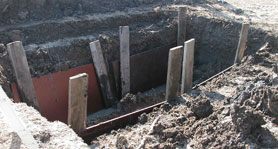
Activity Description
- This activity sheet is for workers required to work in or around trenches, including entrants, competent persons, heavy equipment operators, and their supervisors.
- For some operations or situations (e.g., permit-required confined space entry, heavy equipment use) other activity sheets also apply; see related activity sheets below.
- As a result of Hurricanes Katrina and Rita (2005), there will be a need to dig and enter many trenches and excavations to assess and restore utilities and to remove and reduce hurricane-related debris.
- Improper construction of trenches has historically resulted in many construction-related injuries and fatalities due to trench collapses. Such incidents occurred during trench construction, while workers were inside the trench, and while heavy equipment was used too close to the trench.
- Response and recovery workers conducting this operation may be employed by Federal, State, local, and private employers. Review How to Use This Matrix in the introduction for a discussion of how this information may apply to different workers.
About the Activity Sheet
This activity sheet does not provide an in-depth analysis of OSHA standards and regulations and cannot address all hazards. It does not increase or diminish any OSHA requirement or employer obligation under those requirements. It is intended as a guide and quick reference for employers and response and recovery workers. The Matrix captures major activities involved in hurricane response and recovery, highlights many of the hazards associated with them, and recommends beneficial work practices, personal protective equipment (PPE), and other exposure control methods. Employers must evaluate the specific hazards associated with the job/operation at the site where the work is being performed.
Employers are responsible for providing a safe and healthful workplace for their workers. OSHA's role is to assure the safety and health of America's workers by setting and enforcing standards; providing training, outreach, and education; establishing partnerships; and encouraging continual improvement in workplace safety and health.
The Hazard Exposure and Risk Assessment Matrix for Hurricane Response and Recovery Work provides a general overview of particular topics related to current OSHA standards. It does not alter or determine compliance responsibilities in OSHA standards or the Occupational Safety and Health Act of 1970, or the equivalent State Plan standards and requirements. Because interpretations and enforcement policy may change over time, you should consult current OSHA/State Plan administrative interpretations and decisions by the Occupational Safety and Health Review Commission and the courts for additional guidance on OSHA compliance requirements. Employers should modify their procedures as appropriate when additional, relevant information becomes available.
General Recommendations
Key Engineering Controls and Work Practices. See general recommendations document.
Personal Protective Equipment. The general PPE is recommended for all response/recovery tasks/operations; only the additional PPE that may be needed for a specific hazard is noted below.
General PPE includes:
- Hard hat for overhead impact or electrical hazards
- Eye protection with side shields
- Gloves chosen for job hazards expected (e.g., heavy-duty leather work gloves for handling debris with sharp edges and/or chemical protective gloves appropriate for chemicals potentially contacted)
- ANSI-approved protective footwear
- Respiratory protection as necessary—N, R, or P95, filtering facepieces may be used for nuisance dusts (e.g., dried mud, dirt and silt) and mold (except mold remediation). Filters with a charcoal layer may be used for odors
Recommendations Specific to Hazards Associated with Trenches and Excavations
Key Engineering Controls and Work Practices
- Ensure that a competent person inspects the trench, adjacent areas, and protective systems (where employed) daily and takes any corrective measures necessary before work begins and workers are allowed to enter the trench/excavation. A competent person is able to recognize existing and predictable hazardous conditions and has the authority to take prompt corrective measures to eliminate the hazardous conditions
- Inspections may be needed throughout the shift and must be conducted after every rainstorm and after any other event that increases the risk of hazardous conditions (e.g., possible cave-ins, indications of failure of protective systems, hazardous atmospheres, or other hazardous conditions) if workers will enter the trench/excavation
- Have a competent person classify soil types visually and use at least one manual method (plasticity, dry strength, thumb penetration); soils may be categorized into 3 groups other than solid rock:
- Soil type A is the most stable; it includes clay, silty clay, and hardpan; no type A soils can be fissured, subject to vibration, have been previously disturbed, or be seeping water
- Soil type B is of medium stability; it includes silt, sandy loam, soft clay, submerged soil, and dense heavy unstable rock; it also includes non-type C soils that have previously been disturbed and type A soils that are fissured and subject to vibration
-
Soil type C is the least stable soil type; it includes gravel, loamy sand, soft clay, submerged soil, unstable rock, and soil from which water is freely flowing
- Adequately slope or bench the sides, or use an appropriate protective system (shield, trench box, shoring/hydraulic shoring) based on the soil type
- Sloping and Benching for trenches less than 20 feet in depth: For Type A soils, trenches must be sloped/benched at 53 degrees or less (0.75 horizontal feet for each vertical foot) unless the excavation will only be open for 24 hours or less and is less than 12 feet in depth. In this case the trench may be sloped at 63 degrees or less (0.5 horizontal feet for each vertical foot). For Type B soils, trenches must be sloped/benched at 45 degrees or less (1 horizontal foot for each vertical foot). For Type C soils, trenches must be sloped/benched at 34 degrees or less (1.5 horizontal feet for each vertical foot)
- Sloping and benching for excavations greater than 20 feet in depth: In this case, sloping/benching must be designed by a registered professional engineer
-
For Protective systems: Protective systems must have the capacity to resist, without failure, all loads that are expected to be applied
-
Store all materials, including those removed from the trench or excavation, at least 2 feet away from the sides of the trench or behind a suitable restraining system
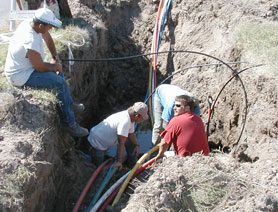
- Ensure that all adjacent buildings/structures or surface obstructions (e.g., trees, large rocks) near the trench are supported or removed
- Support and protect all utilities spanning a trench or excavation
- Provide a fixed means of egress for trenches 4 feet or greater in depth; ensure individuals do not need to travel more than 25 feet to the closest means of egress
- Do not allow response and recovery workers to work in trenches or excavations where water has accumulated or is accumulating unless additional precautions are taken to prevent cave-ins (e.g., additional supports or shield systems, water removal overseen by a competent person)
Key Engineering Controls and Work Practices
- Contact utility companies to assist in locating, marking, and shutting off/purging all underground utility lines that may pose a hazard or may be impacted; ensure that lines have been purged as needed before beginning work
Key Engineering Controls and Work Practices
- Do not carry loads over individuals in a trench or excavation; do not allow response and recovery workers to work under loads suspended over a trench or excavation
- Keep those in the trench clear of the area where material or equipment is being lowered into the trench or excavation
Key Engineering Controls and Work Practices
- If a trench or excavation could contain a hazardous atmosphere (e.g., flammable gases or vapors, oxygen-deficient, toxic gases or vapors), test the atmosphere before and during entry using direct reading monitoring equipment (e.g., combustible gas monitor)
- See Entry into Confined Spaces activity sheet
Key Engineering Controls and Work Practices
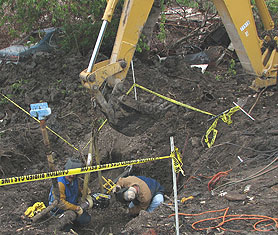
- Use barricades and/or hand or mechanical signals to keep vehicles a safe distance from trenches
- See Heavy Equipment and Powered Industrial Truck Use activity sheet
Additional Personal Protective Equipment
- ANSI/ISEA 107-2004 compliant high visibility safety apparel and headwear
- Hearing protection—see Noise hazard
Key Engineering Controls and Work Practices
- Inspect ladders for cracked, broken, or defective parts before use
- Do not exceed the load rating of ladders—remember that load ratings include people, tools, and equipment
- Set up ladders on stable surfaces
- Set extension or straight ladders at a 75 degree angle from the ground (1/4 foot back for every foot of rise) and provide 3 feet above an upper landing surface to ease climbing onto/descending from height
- Use non-conductive ladders (e.g., fiberglass) and exercise extreme caution when working near power lines
- Secure ladders that can be displaced by work activities; consider barricades at the base to keep traffic away
Key Engineering Controls and Work Practices
- Use ground-fault circuit interrupters (GFCIs) or double insulated power tools, or implement an assured equipment grounding program
- Inspect power tool condition (including any cords) and verify operation of safety features before use
- Do not use equipment that is defective, such as equipment with inoperable safety switches, missing guards, frayed/cut cords etc.
- Ground power tools properly
- Avoid standing in wet areas when using portable power tools
Additional Personal Protective Equipment
- Hearing protection—see Noise hazard
- Hand protection for cut- and abrasion-control and vibration dampening
- Eye protection appropriate to the impact hazard
Key Engineering Controls and Work Practices
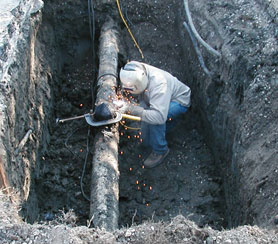
- Remove flammable and combustible materials from the area
- Do not perform "hot work" such as welding, cutting, or burning in areas where flammable, combustible, corrosive, or toxic substances are being used, stored, or may otherwise be present
- Maintain a fire watch during all hot work until material has cooled
- Ensure fire extinguishers and extinguishing agents are available in the immediate area
- Provide natural, exhaust, or forced ventilation to control exposure to the metal fumes and other contaminants being generated (e.g., generator exhaust)
- Ensure that pipes and other vessels are purged of hazardous materials
- Identify building materials that will be welded, cut, or burned and that may contain lead, such as painted surfaces and pipes. Test materials and provide exposure controls identified in 29 CFR 1926.62 as necessary; see the lead hazard in the general recommendations document
Additional Personal Protective Equipment
- Gloves and protective clothing for the activity being performed
- At a minimum, filtered lenses and face-protection as appropriate for the activity being performed
- Respiratory protection based on anticipated exposure to metal fumes, including lead
Key Engineering Controls and Work Practices
- Segregate and store incompatible chemicals separately. For example, store solvents and oxidizers (e.g., peroxides) separately, and acids and caustics separately
- Secure compressed gas cylinders and ensure that they are stored properly when not in use (regulators off and valve caps on when not in use; separate oxygen and fuel gas by 20 feet or using a non-combustible barrier (5 ft high, fire-resistant rating of at least ½ hour))
- Store chemicals in containers approved and designed for chemical storage and mark all storage locations
- Store and handle hazardous materials in areas with natural or forced ventilation; do not store or handle in low-lying areas
- Isolate, secure and identify storage areas
- Prohibit smoking near storage areas
- Keep ignition sources at least 25 feet away from storage areas
- Ensure that fire extinguishers and extinguishing agents are available in the immediate area
- Bond and ground containers before dispensing flammable liquids. Reference 29 CFR 1926.152(e)(2)
Additional Personal Protective Equipment
- Gloves made of material that will protect user from chemicals handled
- Face shield or goggles with indirect venting. If a face shield is selected, eye protection must be worn under the face shield
- Coveralls or apron resistant to chemicals being handled
- Disposable boot covers resistant to the chemicals being handled
- A respirator and cartridges specific for chemical, as necessary
Key Engineering Controls and Work Practices
- Never attach a generator directly to the electrical system of a structure unless a qualified electrician has installed a transfer switch for the generator. If the structure's electrical system is not isolated, it may energize the utility's wiring system for great distances and create a risk of electrocution for utility workers and others in the area
- Always plug electrical equipment directly into the generator using the manufacturer's supplied cords or grounded (3-pronged) extension cords that are rated for the total anticipated load
- Do not overload a generator; it can overheat and create a fire hazard
- Ground and bond generators according to the manufacturer's recommendations; ensure that any manufacturer-required connections are secure before using the generator
- Keep the generator dry; protect with a canopy if needed; do not use it in wet or rainy conditions
- Carbon monoxide (CO) is a poisonous, colorless, and odorless gas that is produced by the incomplete burning of the generator's fuel. CO is harmful when breathed because it displaces oxygen in the blood and deprives the heart, brain, and other vital organs of oxygen
- Never use a generator indoors or in enclosed spaces such as garages and basements; opening windows and doors may not prevent CO from building up in those spaces. Do not use a generator outdoors near doors, windows, and vents that could allow CO to enter
- Ensure that a generator has 3 to 4 feet of clear space on all sides and above it to ensure adequate ventilation and cooling
- Before refueling, shut down the generator and allow it to cool
Additional Personal Protective Equipment
- Hearing protection—see Noise hazard
Key Engineering Controls and Work Practices
- Place generators, compressors, and other noisy equipment at a distance or behind a barrier when possible
Additional Personal Protective Equipment
- Hearing protection when working around potential noise sources and when noise levels exceed 90 dBA. A useful "rule of thumb"—if you cannot hold a conversation in a normal speaking voice with a person who is standing at arms length (approximately 3 feet), the noise level may exceed 90 dBA
Key Engineering Controls and Work Practices
- Stay upwind of or away from dust-generating activities, and in particular those involving crystalline silica-containing materials like concrete, brick, tile, drywall, mortar, sand, or stone. When inhaled, the fine crystalline silica particles contained in the dust can become lodged deep in the lung, which can lead to silicosis and other respiratory illnesses
- Use water spray or mist to suppress dust generation, especially during operations that may create a lot of dust, such as cutting or sawing silica-containing materials, jack hammering, impact drilling, using heavy equipment, and demolishing structures
- Avoid using compressed air for cleaning surfaces
- Sample worker exposures to silica during dust-generating activities
Additional Personal Protective Equipment
- At a minimum, use respirators with N, R, or P95 filters for work with crystalline silica-containing materials (e.g., concrete, brick, tile, mortar). The use of N, R, or P100 filters may provide additional protection. Higher levels of respiratory protection may be needed for some operations (e.g., cutting concrete, sandblasting, mixing concrete)
- N, R, or P95 respirators may be used for nuisance dusts (e.g., dried mud, dirt, or silt) and mold (except mold remediation). Filters with a charcoal layer may be used for odors
Key Engineering Controls and Work Practices
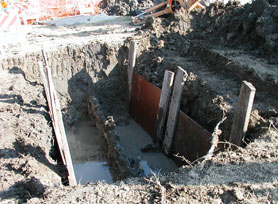
- If hazardous chemical containers are found or leaking materials are detected:
- Do not use spark-producing devices (e.g., engines, tools, electronic, and communications equipment) in the immediate area
- Take self-protective measures (i.e., move to a safe distance upwind) and contact hazardous material response personnel for evaluation/removal before continuing work in the area
Additional Personal Protective Equipment
- Evaluate the need to revise protective clothing, respirator, and glove selection
Select any of the following potential hazards that can be associated with this activity in order to access relevant recommendations in the general recommendations document:
- Slips, trips, and falls on working surfaces
- Environmental hazards
Additional Medical Needs
- Follow medical guidance and precautions outlined in the general recommendations document
Additional Training Needs
- Follow general site- and task-specific training guidelines as outlined in the general recommendations document
- Competent persons should be trained on soil-type recognition, trench construction, worker protection techniques, and initial and periodic trench inspection requirements
Related Activity Sheets
- Entry into Confined Spaces
- Heavy Equipment and Powered Industrial Truck Use
- Work Zone Safety and Traffic Control within a Work Area
Other Resources and References
- 29 CFR 1926 Subpart P, Excavations. OSHA.
- 29 CFR 1926 Subpart J, Welding and cutting. OSHA.
- 29 CFR 1926 Subpart X, Ladders. OSHA.
- 29 CFR 1926 Subpart I, Hand and power tools. OSHA.
- Trenching and Excavation. OSHA Safety and Health Topics Page.
- Procedures for Atmospheric Testing in Confined Spaces. OSHA Quick Card, (2005).
- Storm/Flood and Hurricane Response. National Institute for Occupational Safety and Health (NIOSH) Workplace Safety and Health Topic.
- Respiratory Protection. OSHA Safety and Health Topics Page.
- NIOSH Respirator Selection Logic 2004. Centers for Disease Control and Prevention (CDC).
- Using Portable Generators Safely. OSHA Fact Sheet, (2005).
- Work Zone Traffic Safety. OSHA Fact Sheet, (2005).
- Manual on Uniform Traffic Control Devices (MUTCD). U.S. Department of Transportation, Federal Highway Administration.

